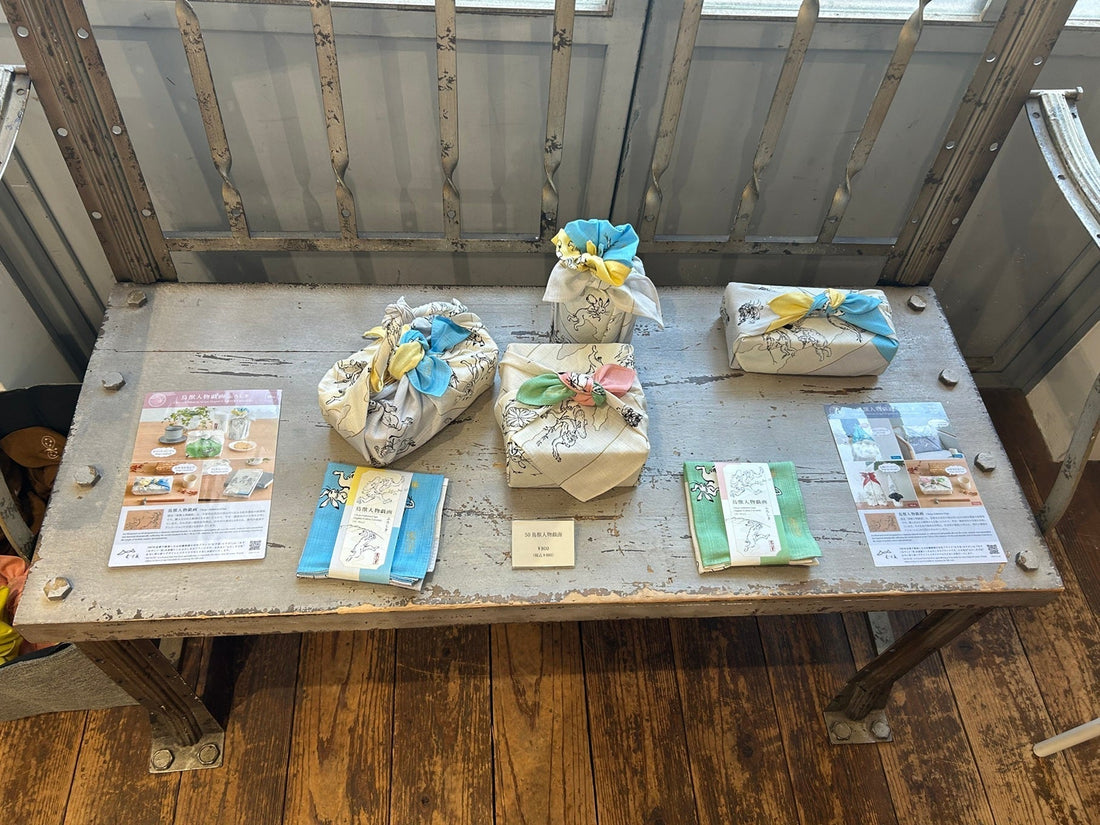Hello
I'm Narushima, a staff member at the Haneda Airport store.
This time, we had the opportunity to visit the Tokyo exhibition of new products by Musubi, a Kyoto-based manufacturer specializing in furoshiki wrapping cloths.
The theme this time is "Creative Breeze"
The following is a quote from Musumi's website.
The theme of this issue comes from the Zen phrase "Step by step, a fresh breeze arises."
A literal translation would be "When he walks, a fresh wind blows around him," but it also suggests the importance of taking small steps on our journey through life.
As our words say, we will continue to cherish each and every step we take and strive to create a clean wind.
Musubi's new furoshiki
As soon as I stepped into the venue, I saw the new furoshiki on display. The first thing that caught my eye was the new "Choju Jinbutsu Giga" painting.
50 Choju Jinbutsu Giga (50cm)
This furoshiki is designed based on the picture scroll of Choju Jinbutsu Giga.
The Choju Jinbutsu Giga is a scroll of ink painting on paper handed down at Kozan-ji Temple in Ukyo Ward, Kyoto City.
It depicts anthropomorphized animals, and its free and cheerful style is said to be Japan's first manga, as well as the origin of manga and animation.
This design has a different color on each of the four corners, allowing you to enjoy different looks depending on the direction you wrap it, which gives it a very cute look.
The designs also incorporate minor animals from the Choju Jinbutsu Giga paintings that have not been commercialized much until now.
When I looked closely at the furoshiki, I saw that it had gold in it here and there, and I thought its subtle elegance was lovely.
Image taken from Musumi's website
100 Choju Jinbutsu Giga (100cm)
This design is based on the large circle that resembles a bow and arrow target made from lotus leaves, which appears in the story.
When used as an eco-bag, the animals are positioned so that they appear directly at the front.
Finding your favorite animal is part of the fun.
58 Setsugekka (58cm)
This is a series themed on traditional Japanese crafts, depicting scenes of the four seasons and auspicious patterns.
It seems that traditional Japanese crafts have attracted attention across generations and borders, and the motif for the designs was lacquer bowls and octagonal trays, which will be appreciated by people from overseas who love Japanese culture.
I was impressed by how the same furoshiki suddenly exuded a sense of luxury when it was red, black, and gold.
120 Setsugekka (120cm)
This design goes well with fashion and interior design because of the black background. It is a large furoshiki, so it is also recommended as a bag or a stole.
The studio where this exhibition was held has an open ceiling, and the "Setsugetsuka" furoshiki wrapping cloth hanging from the ceiling looked just like a kimono, which I thought was very beautiful. I thought it would be nice to display it as art in a room.
Image taken from Musumi's website
100 Aqua Drop Recycled Round/Square (Water Repellent)
This product uses recycled polyester, which is made from recycled polyester fibers from discarded uniforms and other sources, for the weft of the fabric, and 55% of the total material is recycled polyester.
It is resistant to water and dirt, so it can be used not only as an everyday eco-bag, but also as a bag cover on rainy days.
The water-repellent finish means it can be used in a variety of ways, such as as a tablecloth, for outdoor activities, sports, and even as a diaper changing mat, making it very convenient for childcare. Also, since Japan is a country prone to natural disasters, I thought it could be useful as a disaster prevention item.
Image taken from Musumi's website
As this exhibition was held right in time for Valentine's Day, the walls of the exhibition hall were decorated with heart shapes made from reversible furoshiki wrapping cloths, which was very adorable.
Lecture on Furoshiki wrapping
In the second half of the exhibition, we were given a lecture on how to wrap things in furoshiki.
At the Haneda Airport store, customers often ask us to wrap their products in furoshiki, so we thought this would be a good opportunity to learn different ways to wrap items.
First, we reviewed the basic way to tie a furoshiki, the "true knot." The true knot is difficult to untie, but when you want to untie it, it's a convenient way to tie it with one trick. It's a way to make sure the knot doesn't end up vertically.
Furoshiki ribbon wrapping arrangement
This is an adaptation of the "ribbon wrapping" style, where the ribbon is replaced with flowers.
Using a reversible furoshiki will make the decorative parts different colors, making it more gorgeous.
Wrapping flowers in furoshiki (no rubber bands)
This is a flower wrapping method that does not use rubber bands.
Normally, flowers are wrapped using rubber bands, but we were taught a different way to wrap flowers even when rubber bands are not available.
In addition to wrapping, we were taught how to arrange haori and skirts using large furoshiki. Furoshiki are convenient items that can be used freely, and are very fashionable as fashion items. Large furoshiki can be used to its full potential to arrange haori and skirts in a variety of styles.
It was a wonderful experience to be able to realize the value of furoshiki once again through this exhibition. We would like to continue to convey the charm of furoshiki to more people by skillfully handling them at our Haneda Airport store and spreading awareness of their practical aspects and cultural significance.


